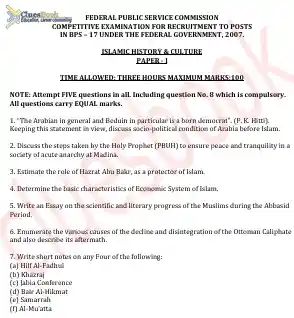Download CSS Past Paper of Islamic History and Culture 2007 PDF with insights on structure, unique features, strategies, and comparisons to later papers. Includes useful tables for quick reference.

| Element | 2007 Paper Focus | Notable Aspect |
| Question Nature | Narrative + factual | More descriptive than later |
| Main Topics | Caliphate, rulers, institutions | Limited cultural depth |
| Difficulty Level | Moderate to High | Heavy recall expected |
| Relevance Today | Good for factual foundations | Less aligned with modern CSS |
CSS Past Paper of Islamic History and Culture 2007 – Outline of the Paper
The 2007 CSS paper leaned heavily towards political and institutional history, focusing on the Caliphate era, leadership models, and Islamic governance. Compared to later years, it was less analytical and more event-driven.
Distinctive Features
- Primarily centered on early Islamic leadership.
- Lesser weight on intellectual and cultural contributions.
- Direct, descriptive questions requiring precise recall.
- Examiner’s preference for fact-heavy answers.
About the CSS
The CSS (Central Superior Services) Competitive Examination is a rigorous federal-level test administered by the Federal Public Service Commission (FPSC) to select candidates for prestigious civil service roles across Pakistan. The exam’s rules and regulations, covering age limits, eligibility, subjects, and quotas, are detailed in the official CSS Rules section on the FPSC’s website.
The CSS Exam Rules, issued by FPSC Pakistan, outline eligibility criteria, age limits (21–30 years), and a maximum of three attempts for candidates. The exam includes written tests, a medical exam, a psychological assessment, and an interview. Rules also define quotas, disqualification grounds, and subject selection for a fair recruitment process.
Topics Covered
- Rashidun and Umayyad periods.
- Development of Islamic political institutions.
- Expansion of Islam through governance.
- Limited mention of philosophy and culture.
Examiner’s Direction
The examiner’s clear intent was to test:
- Historical memory of candidates.
- Clarity on chronological order of events.
- Familiarity with dynasties and rulers.
Student’s Perspective
Students often noted that:
- The paper was predictable yet detail-heavy.
- Answers required mastery of dates and rulers.
- Lack of variety made it tough for those strong in cultural analysis.
Preparation Guidance
- Create structured notes by era (Caliphate, Umayyad, Abbasid).
- Prioritize facts, names, and events.
- Keep cultural elements in revision for balance.
- Practice direct, point-to-point answers.
Comparison with 2008 Paper
| Aspect | 2007 Paper | 2008 Paper |
| Focus Area | Caliphate, rulers, governance | Political rulers, battles |
| Question Style | Descriptive, direct | Descriptive but event-heavy |
| Examiner’s Goal | Recall of institutions & leaders | Recall of rulers & dynasties |
| Student Difficulty | Factual precision | Memorization of events/dates |
Download CSS Past Paper of Islamic History and Culture 2007
You can access the CSS Past Paper of Islamic History and Culture 2007 (PDF) in the link below. It is unsolved and useful for self-practice. The CSS Past Paper of 2007 in Islamic History and Culture remains a fact-based exam, setting the stage for a transition toward more analytical papers in later years.
While challenging in terms of memorization, it offers CSS aspirants a solid base for understanding leadership and institutional development in Islamic history.

